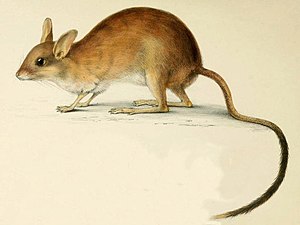Long-tailed jumping mouse
| Long-tailed jumping mouse | ||||||||||||
|---|---|---|---|---|---|---|---|---|---|---|---|---|

Long-tailed jumping mouse ( Notomys longicaudatus ) |
||||||||||||
| Systematics | ||||||||||||
|
||||||||||||
| Scientific name | ||||||||||||
| Notomys longicaudatus | ||||||||||||
| ( Gould , 1844) |
The long-tailed jumping mouse ( Notomys longicaudatus ) is an extinct rodent belonging to the genus of the Australian jumping mice ( Notomys ). The Aborigines called them koolawa . It used to be widespread in the arid regions of South and Central Australia. The back was sandy brown, the underside white. The tail was light brown on top and white on the underside with dark fuzz. The head-trunk length was between 110 and 160 mm, the tail length 160 to 205 mm, the hind foot length 40 to 45 mm, the ear length 24 to 28 mm. It reached a weight of 100 g. This made it one of the largest species of jumping mouse. The females had four teats. Little is known about their way of life. She evidently preferred firm, loamy soil to dig holes in. Although it liked to eat raisins, it was not a nuisance to the settlers' granaries. It was discovered in 1843 by the naturalist John Gilbert . Only a handful of specimens had been caught up to the last verified record in 1901. However, it probably survived much longer, as skull fragments were found in the dungeon of an owl in 1977 and assigned to this species.
Two specimens are in the World Museum Liverpool .
literature
- Tim Flannery , Peter Schouten : A Gap in Nature. Discovering the World's Extinct Animals. Atlantic Monthly Press, New York NY 2001, ISBN 0-87113-797-6 .
- Peter Menkhorst: A Field Guide to the Mammals of Australia. Illustrated by Frank Knight. Oxford University Press, South Melbourne et al. 2001, ISBN 0-19-550870-X .
Web links
- Notomys longicaudatus in the endangered Red List species the IUCN 2006 Posted by: J. Baille, 1996. Retrieved on October 31 of 2006.